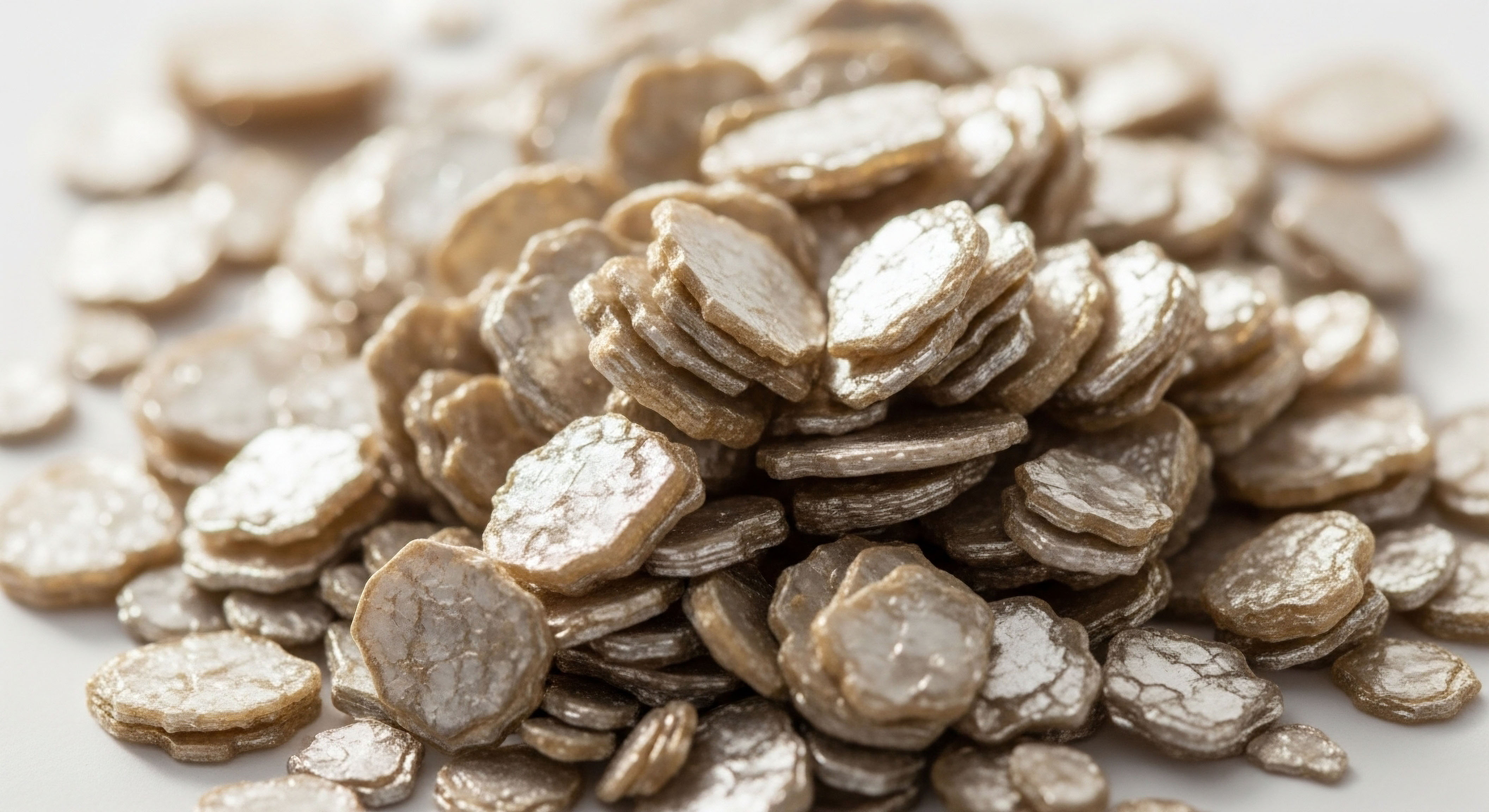

Fundamentals
Your body communicates with itself through an intricate language of molecular messengers. Peptides are a fundamental part of this dialogue, acting as precise signals that direct complex processes like tissue repair, inflammation control, and metabolic regulation. When an athlete considers peptide protocols, the core objective is to introduce a specific, targeted message to enhance the body’s natural capacity for performance and recovery.
The efficacy of this message, however, depends entirely on the environment in which it is received. A system primed with optimal nutrition and restorative practices will interpret and execute these signals with far greater fidelity.
Think of your biological systems as a highly advanced orchestra. The introduction of a therapeutic peptide is like handing a new musical score to a specific section. For that score to be played beautifully, the instruments must be in tune, the musicians must be rested, and the conductor ∞ your overall lifestyle ∞ must be leading with clarity.
Dietary and lifestyle factors are the elements that tune these instruments. They ensure the raw materials for cellular function are available and that the body’s internal state is one of readiness and receptivity. This preparation is the foundation upon which peptide efficacy is built.

The Cellular Environment as the Foundation
Every signal sent by a peptide must be received by a receptor on a cell’s surface. The health and sensitivity of these receptors are directly influenced by your daily habits. Chronic inflammation, driven by a diet high in processed foods or inadequate recovery, can dampen receptor sensitivity, making it harder for the peptide’s message to be heard.
Conversely, a diet rich in anti-inflammatory compounds and a lifestyle that prioritizes sleep create a cellular environment that is highly responsive. Your choices directly cultivate the biological terrain where these powerful molecules operate.
The body’s response to peptide signals is conditioned by the nutritional and metabolic state you actively maintain.
This understanding shifts the perspective on peptide use. It becomes a collaborative process between a therapeutic agent and a well-managed biological system. The athlete’s role extends beyond administration of the protocol to the diligent cultivation of a physiological state that can optimally utilize these advanced tools. The journey toward enhanced function is an integrated one, where what you do every day matters as much as the specific protocol you employ.

Why Does Nutrient Availability Matter?
Peptides that signal for muscle growth or tissue repair initiate a cascade of events that require resources. These resources are the amino acids, vitamins, and minerals supplied by your diet. For instance, a growth hormone secretagogue may send a powerful signal to build lean tissue, but if the essential amino acid building blocks are absent, the signal cannot be fully translated into a physical outcome.
A well-formulated nutritional plan, therefore, acts as the logistical support for the commands issued by the peptides, ensuring the necessary materials are on-site for the work to begin.


Intermediate
To comprehend how diet and lifestyle modulate peptide efficacy, we must examine the specific biological mechanisms at play. The relationship is synergistic. Lifestyle inputs can amplify the intended effects of a peptide protocol by supporting the same physiological pathways the peptide targets. A prime example is the interplay between collagen peptide supplementation and resistance training.
The mechanical stress of the training acts as a primary stimulus for tissue adaptation, while the peptides provide specific amino acids like glycine and proline, which are crucial for collagen synthesis, enhancing the repair and strengthening of connective tissues like tendons and ligaments.

The Synergy of Action and Substrate
Many peptides used by athletes, such as those in the growth hormone secretagogue (GHS) family like Ipamorelin or CJC-1295, function by stimulating the body’s own production of growth hormone (GH). The efficacy of this amplified GH pulse is then contingent on several downstream factors. Optimal sleep is one of the most critical.
The body’s largest natural GH pulse occurs during deep, slow-wave sleep. By aligning peptide administration with the body’s natural circadian rhythm and ensuring high-quality sleep, an athlete can compound the therapeutic effect. The peptide enhances the signal, and the deep sleep provides the ideal physiological window for that signal to be translated into repair and regeneration.

Dietary Influence on Peptide Signaling Pathways
Your nutritional choices directly influence the hormonal and metabolic environment that peptides interact with. A diet with adequate protein intake does more than just supply building blocks; it influences signaling molecules. For example, the amino acid leucine, found in high-quality protein sources, is a direct activator of the mTOR pathway, a central regulator of muscle protein synthesis.
When using peptides designed to promote anabolism, a diet sufficient in leucine ensures this key pathway is primed for activation. The peptide opens the door for growth, and the dietary components provide the stimulus to walk through it.
Lifestyle choices like sleep hygiene and nutrient timing directly prepare the body’s signaling pathways for optimal peptide interaction.
The following table illustrates how specific lifestyle factors can potentiate or diminish the effectiveness of peptide protocols:
| Lifestyle Factor | Positive Influence on Peptide Efficacy | Negative Influence on Peptide Efficacy |
|---|---|---|
| Nutrient Timing | Consuming protein/carbohydrates post-exercise can enhance the anabolic window, supporting the action of peptides like Sermorelin or Tesamorelin. | Large meals high in carbohydrates immediately before GHS administration can elevate blood glucose and insulin, potentially blunting the subsequent GH release. |
| Training Modality | Resistance training creates the micro-trauma and stimulus that growth-promoting peptides act upon to build muscle and strength. | Overtraining without adequate recovery elevates catabolic hormones like cortisol, which can counteract the anabolic signals from peptides. |
| Sleep Quality | 7-9 hours of quality sleep maximizes the body’s natural GH pulses, creating a synergistic effect with administered GHS peptides. | Poor sleep disrupts the hypothalamic-pituitary-adrenal (HPA) axis, leading to hormonal dysregulation that can interfere with peptide signaling. |
| Hydration Status | Proper hydration is essential for cellular function, nutrient transport, and maintaining blood volume, all of which support metabolic processes influenced by peptides. | Dehydration can impair cellular signaling and metabolic efficiency, reducing the overall effectiveness of any therapeutic intervention. |

What Is the Role of Gut Health in Peptide Absorption?
Many peptides are administered via subcutaneous injection to bypass the gastrointestinal tract. However, the overall health of the gut microbiome still plays a profound role. A healthy gut lining and a balanced microbiome help regulate systemic inflammation. High levels of systemic inflammation can create resistance to anabolic signals and impair recovery.
Furthermore, some peptides are derived from dietary sources, such as bioactive peptides from whey protein hydrolysate or marine collagen. The absorption and ultimate bioactivity of these oral peptides are directly dependent on the digestive and absorptive capacity of the gut, making a healthy GI system a prerequisite for their effectiveness.


Academic
A sophisticated analysis of peptide efficacy in athletes requires a systems-biology perspective, examining the intricate crosstalk between therapeutic peptides, endogenous signaling pathways, and the metabolic milieu shaped by diet and lifestyle. The interaction is not a simple cause-and-effect relationship; it is a complex modulation of pre-existing biological networks.
The efficacy of a given peptide is contingent upon the athlete’s unique physiological state, including their baseline hormonal levels, inflammatory status, and even the composition of their gut microbiota.

Molecular Synergy between Bioactive Peptides and Training Stimuli
Bioactive peptides, which can be derived from dietary sources like milk, fish, or plants, are themselves potent signaling molecules. For example, whey protein hydrolysate contains dipeptides and tripeptides that are absorbed intact and may exert biological effects beyond their nutritional value as amino acid sources.
Some research suggests that specific dipeptides, like leucine-valine, may directly influence the expression of the mechanistic target of rapamycin (mTOR), a pivotal regulator of muscle hypertrophy. This creates a scenario of dual signaling ∞ an athlete might use a GHS peptide like Tesamorelin to increase IGF-1 levels, while simultaneously consuming a whey hydrolysate post-exercise.
The Tesamorelin promotes a systemic anabolic signal, while the bioactive peptides from the whey provide a direct, localized stimulus to the mTOR pathway within muscle cells. This combined effect represents a multi-pronged approach to potentiating adaptation.
The following table details the interaction between specific peptide classes and key influencing factors:
| Peptide Class | Primary Mechanism | Key Dietary/Lifestyle Synergies | Relevant Research Insight |
|---|---|---|---|
| Growth Hormone Secretagogues (e.g. CJC-1295, Ipamorelin) | Stimulate pituitary GH release. | Fasted state administration; high-quality sleep; adequate protein intake for substrate. | Efficacy can be blunted by high circulating glucose and insulin, making meal timing a critical variable. |
| Collagen Peptides | Provide specific amino acids for connective tissue synthesis. | Combined with resistance or targeted exercise; sufficient Vitamin C intake (cofactor for collagen synthesis). | Studies show significant increases in tendon cross-sectional area when supplementation is paired with a resistance training program. |
| GLP-1 Receptor Agonists (e.g. Liraglutide) | Regulate glucose metabolism and appetite. | Concurrent physical exercise preserves muscle mass and enhances fat loss. | The combination of GLP-1 agonism and exercise produces synergistic effects on long-term weight management and body composition. |

How Does the Body’s Inflammatory State Dictate Peptide Response?
The athlete’s inflammatory baseline is a critical, yet often overlooked, variable. Intense training naturally produces an acute inflammatory response, which is a necessary signal for adaptation and repair. Peptides like Pentadeca Arginate (PDA) or BPC-157 are often used to modulate this response and accelerate healing.
However, if an athlete has high levels of chronic, systemic inflammation due to factors like poor diet, inadequate sleep, or high stress, the system can become desensitized. This chronic inflammatory state creates “signal noise,” making it difficult for the targeted anti-inflammatory and pro-repair signals from the peptides to be effectively registered by the cells.
A lifestyle focused on mitigating chronic inflammation ∞ through a diet rich in omega-3 fatty acids, antioxidants, and polyphenols ∞ is essential for ensuring the clarity and impact of these regenerative peptide signals.
The athlete’s inflammatory baseline and gut microbiome composition are key determinants of their response to peptide therapies.

Limitations and Future Directions
It is important to acknowledge the limitations of the current body of research. Many studies on peptide efficacy are conducted on untrained or older populations, and the results may not be directly transferable to elite, well-trained athletes. The anabolic potential of certain peptides might show a ceiling effect in individuals who are already close to their genetic potential.
Furthermore, the long-term safety and systemic effects of many of these compounds are still under investigation. Future research must focus on well-controlled trials in athletic populations, examining not just performance metrics but also the complex interplay with dietary patterns, training volumes, and individual biomarkers to move towards a truly personalized application of peptide therapies.
Here is a list of key considerations for optimizing peptide efficacy:
- Baseline Assessment ∞ An athlete should understand their baseline hormonal and inflammatory markers before beginning any protocol.
- Nutritional Sufficiency ∞ The diet must provide adequate macronutrients (especially protein) and micronutrients to support the cellular processes initiated by the peptides.
- Training Integration ∞ The training stimulus must be appropriately matched to the peptide’s mechanism of action (e.g. resistance training for anabolic peptides).
- Recovery Prioritization ∞ Sleep and stress management are non-negotiable components for optimizing the endocrine system’s response to peptide inputs.

References
- Alang, M. K. & Fell, G. S. “The Role of Peptides in Nutrition ∞ Insights into Metabolic, Musculoskeletal, and Behavioral Health ∞ A Systematic Review.” Medicina, vol. 59, no. 7, 2023, p. 1229.
- Gleeson, M. “Bioactive Peptides in Sports Nutrition.” Journal of Sports Sciences, vol. 39, no. sup1, 2021, pp. 1-4.
- O’Bryan, K. R. & Johnson, D. L. “Peptides for Bodybuilding ∞ Do They Work, and Are They Safe?.” Healthline, 3 Dec. 2020.
- König, D. et al. “Potential Relevance of Bioactive Peptides in Sports Nutrition.” Nutrients, vol. 13, no. 11, 2021, p. 4043.
- Cahyaningrum, N. et al. “Marine-derived protein ∞ peptide bioresources for the development of nutraceuticals for improved athletic performance.” Frontiers in Nutrition, vol. 10, 2023.

Reflection

Calibrating Your Internal Systems
The information presented here offers a map of the intricate connections between targeted peptide protocols and the foundational pillars of health. This knowledge is the first step. The true application of this science begins with a period of introspection and self-assessment. Consider your own daily inputs ∞ your nutrition, your sleep, your training, your stress.
View them not as separate chores, but as the dials you can turn to calibrate your internal environment. Understanding your own biology is the ultimate tool for unlocking your potential. This journey is about moving from a passive state of experiencing symptoms to a proactive state of managing systems. Your body is constantly communicating its needs; the goal is to learn how to listen and respond with precision.



